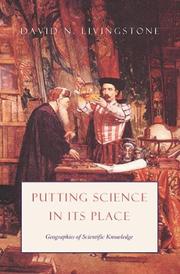Check nearby libraries
Buy this book

"Putting Science in Its Place establishes the fundamental importance of geography in both the generation and the consumption of scientific knowledge, using historical examples of the many places where science has been practiced. Livingstone first turns his attention to some of the specific sites where science has been made - the laboratory, museum, and botanical garden, to name some of the more conventional locales, but also places like the coffeehouse and cathedral, ship's deck and asylum, even the human body itself. In each case, he reveals just how the space of inquiry has conditioned the investigations carried out there.
He then describes how, on a regional scale, provincial cultures have shaped scientific endeavor and how, in turn, scientific practices have been instrumental in forming local identities. Widening his inquiry, Livingstone points gently to the fundamental instability of scientific meaning, based on case studies of how scientific theories have been received in different locales. Putting Science in Its Place concludes by by examining the remarkable mobility of science and the seemingly effortless way it moves around the globe."--Jacket.
Check nearby libraries
Buy this book

Previews available in: English
Showing 2 featured editions. View all 2 editions?
| Edition | Availability |
|---|---|
|
1
Putting Science in Its Place
2010, University of Chicago Press
Electronic resource
in English
0226487245 9780226487243
|
zzzz
Libraries near you:
WorldCat
|
|
2
Putting Science in Its Place: Geographies of Scientific Knowledge
October 1, 2003, University Of Chicago Press, University of Chicago Press
Hardcover
in English
0226487229 9780226487229
|
aaaa
Libraries near you:
WorldCat
|
Book Details
First Sentence
"Scientific knowledge is made in a lot of different places."
Classifications
The Physical Object
ID Numbers
Source records
amazon.com recordIthaca College Library MARC record
Internet Archive item record
Better World Books record
Library of Congress MARC record
Internet Archive item record
Promise Item
marc_nuls MARC record
harvard_bibliographic_metadata record
Work Description
We are accustomed to thinking of science and its findings as universal. After all, one atom of carbon plus two of oxygen yields carbon dioxide in Amazonia as well as in Alaska; a scientist in Bombay can use the same materials and techniques to challenge the work of a scientist in New York; and of course the laws of gravity apply worldwide. Why, then, should the spaces where science is done matter at all? David N. Livingstone here puts that question to the test with his fascinating study of how science bears the marks of its place of production. Putting Science in Its Place establishes the fundamental importance of geography in both the generation and the consumption of scientific knowledge, using historical examples of the many places where science has been practiced. Livingstone first turns his attention to some of the specific sites where science has been made—the laboratory, museum, and botanical garden, to name some of the more conventional locales, but also places like the coffeehouse and cathedral, ship's deck and asylum, even the human body itself. In each case, he reveals just how the space of inquiry has conditioned the investigations carried out there. He then describes how, on a regional scale, provincial cultures have shaped scientific endeavor and how, in turn, scientific practices have been instrumental in forming local identities. Widening his inquiry, Livingstone points gently to the fundamental instability of scientific meaning, based on case studies of how scientific theories have been received in different locales. Putting Science in Its Place powerfully concludes by examining the remarkable mobility of science and the seemingly effortless way it moves around the globe. From the reception of Darwin in the land of the Maori to the giraffe that walked from Marseilles to Paris, Livingstone shows that place does matter, even in the world of science.
Community Reviews (0)
Feedback?History
- Created April 30, 2008
- 16 revisions
Wikipedia citation
×CloseCopy and paste this code into your Wikipedia page. Need help?
| September 19, 2024 | Edited by MARC Bot | import existing book |
| March 8, 2023 | Edited by MARC Bot | import existing book |
| December 4, 2022 | Edited by ImportBot | import existing book |
| October 14, 2022 | Edited by ImportBot | import existing book |
| April 30, 2008 | Created by an anonymous user | Imported from amazon.com record |











